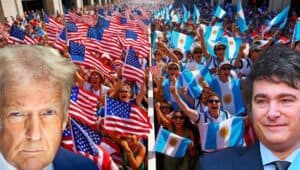Disruptor-in-Chiefs: How Trump’s Trade Wars and Milei’s Libertarian Overhaul Redefined Economic Shock Therapy
Two leaders, two playbooks—one aimed at walls, the other at wrecking balls. Trump’s tariff blitzkrieg reshuffled global supply chains like a rogue algorithm, while Milei slashed Argentina’s state apparatus with the precision of a crypto hard fork.
Trade War 2.0: The Art of the (Forced) Deal
Trump weaponized tariffs as blunt-force policy tools—no smart contracts, just old-school coercion. Supply chains scrambled to reroute, proving even legacy systems can ’move fast and break things’ when governments brute-force the code.
Milei’s Austerity Protocol: Argentina’s Hard Reset
Dollarization as the ultimate stablecoin. Milei didn’t just trim fat—he open-sourced Argentina’s economic stack, burning pesos like a memecoin rug pull. The IMF? Just another middleman getting disintermediated.
The punchline? Both proved that when traditional finance fails, extreme measures get mainstreamed faster than a Bitcoin ETF approval. Just don’t ask who’s left holding the bags.

Donald Trump and Javier Milei both represent radical economic shifts in their respective countries, yet their approaches diverge sharply in both philosophy and implementation.
Trump’s Economic Doctrine: Nationalist Mercantilism
Trump’s economic policies center on economic nationalism and mercantilism. His administration implemented wide-ranging tariffs targeting China, Europe, and other trade partners, under the premise of protecting American industry and restoring domestic manufacturing. He withdrew from multilateral trade agreements, sought to repatriate supply chains, and promoted a weak-dollar policy while using tariffs as tools of geopolitical leverage. Simultaneously, Trump moved to reduce the social function of government, cutting regulatory oversight and attempting to reduce welfare spending. However, he maintained large federal budgets, including stimulus during crises, contradicting strict fiscal conservatism.
Milei’s Economic Doctrine: Radical Libertarianism
Milei, elected on a promise to abolish Argentina’s “caste” of political elites, has embraced a much more ideologically pure libertarian model. His plan includes massive reductions in state spending, dismantling government ministries, eliminating subsidies, privatizing state assets, and proposing full dollarization of the Argentine economy. Unlike Trump, Milei aggressively opposes tariffs, state intervention, and even central banking as a concept. His CORE thesis is that government should exit nearly all areas of the economy, which marks a sharp departure from both leftist populism and nationalist conservatism.
Trump Vs Milei – Key Differences
Trump supports protectionism via tariffs; Milei supports free trade and opposes tariffs.
Trump maintains a nationalist state with strategic interventions; Milei seeks near-complete withdrawal of the state from economic life.
Trump blends populism with mercantilism; Milei is driven by Austrian economics and anarcho-capitalist theory.
Both aim to reduce dependency, but Trump maintained large-scale federal support during crises, while Milei aims to cut social spending drastically regardless of conditions.
Conclusion
Trump’s reforms are tactical, aimed at strategic advantage and national sovereignty, while Milei’s are doctrinal, targeting ideological transformation. Both disrupt the postwar economic consensus but from opposite directions — Trump from the right-wing nationalist playbook, Milei from the libertarian anti-state one.

